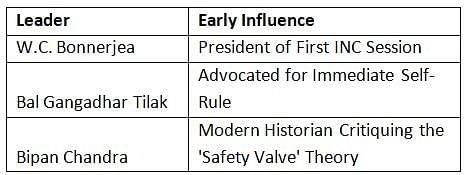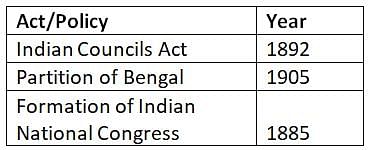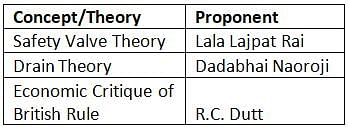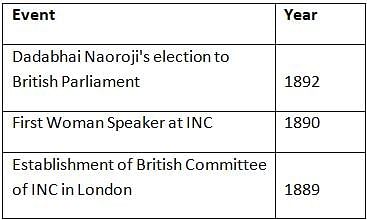Spectrum Test: The Foundation & the Moderate Phase of the INC - UPSC MCQ
20 Questions MCQ Test History for UPSC CSE - Spectrum Test: The Foundation & the Moderate Phase of the INC
Consider the following pairs:

How many of the above pairs are correctly matched?

How many of the above pairs are correctly matched?
Assertion (A): The Indian Councils Act of 1892 was criticized by nationalist leaders.
Reason (R): It significantly increased the representation and powers of Indians in the legislative councils.
In the context of the above, which one of the following is correct?
Consider the following statements:
- The Indian National Congress (INC) was founded with the aim of establishing a democratic and nationalist movement in India.
- A.O. Hume is credited with the foundation of the INC as a measure to prevent any possible uprising against the British rule.
How many of the statements given above are correct?
Assertion (A): The formation of the Indian National Congress was influenced by earlier meetings such as the Indian National Conferences.
Reason (R): The Indian National Conferences laid the groundwork for a pan-Indian organization by bringing together leaders from different regions.
In the context of the above, which one of the following is correct?
Consider the following statements:
- Kadambini Ganguly was the first woman to speak at an INC meeting, highlighting the importance of women in the freedom struggle.
- The Moderate phase of the Indian National Congress focused on demanding the right to vote for all Indians, including women.
How many of the statements given above are correct?
Consider the following statements:
- The early nationalists introduced the "drain theory" to articulate how wealth was being extracted from India to Britain.
- The Indian Councils Act of 1892 significantly increased the powers of legislative councils in India, especially in financial matters.
How many of the statements given above are correct?
Consider the following pairs:

How many of the above pairs are correctly matched?
Consider the following statements:
- The British Indian Government was supportive of the Indian National Congress in its early years, seeing it as a means to channel nationalist sentiments.
- The government attempted to divide nationalist ranks by fostering divisions based on religion, using a 'carrot and stick' approach.
How many of the statements given above are correct?
Consider the following pairs:

How many of the above pairs are correctly matched?
Consider the following statements:
- Moderates within the INC advocated for immediate independence from British rule through direct action.
- The early nationalists were successful in generating a wide national awakening among all Indians, creating a unified response against colonial rule.
How many of the statements given above are correct?
- Statement I: The aim of the Indian National Congress during its initial years was to establish a platform for all Indians to unite and articulate their political and economic demands.
- Statement II: The formation of the INC was primarily a response to the British economic policies that were seen as detrimental to the economic interests of Indians.
Which one of the following is correct in respect of the above statements?
Consider the following pairs:

How many of the above pairs are correctly matched?
Assertion (A): The British government adopted a policy of 'divide and rule' to weaken the Indian National Congress.
Reason (R): They encouraged divisions based on religion and social status among nationalists.
In the context of the above, which one of the following is correct?
- Statement I: A.O. Hume played a crucial role in the formation of the Indian National Congress to serve as a safety valve for the discontent among Indians.
- Statement II: The Safety Valve Theory suggests that the Indian National Congress (INC) was created to offer a peaceful means for Indians to express their rising discontent and to avert a potential violent revolution.
Which one of the following is correct in respect of the above statements?
- Statement I: The early nationalists within the Indian National Congress focused on immediate constitutional reforms to bring about self-government.
- Statement II: The demand for self-government was inspired by the models of dominion status granted to colonies like Canada and Australia.
Which one of the following is correct in respect of the above statements?
Assertion (A): The early nationalists were successful in creating a broad public opinion against British rule.
Reason (R): They highlighted the economic exploitation of India through the drain theory and criticized British economic policies.
In the context of the above, which one of the following is correct?
- Statement I: The Moderate leaders of the Indian National Congress advocated for the Indianisation of government service as a key reform.
- Statement II: The demand for Indianisation was based on the belief that greater Indian participation in government would lead to more equitable policies towards India.
Which one of the following is correct in respect of the above statements?
- Statement I: The British government adopted a policy of 'divide and rule' to weaken the Indian National Congress by fostering divisions among its members.
- Statement II: One strategy employed by the British was to encourage the formation of groups like the United Indian Patriotic Association to counter Congress's influence.
Which one of the following is correct in respect of the above statements?
Consider the following pairs:

How many of the above pairs are correctly matched?
Assertion (A): The early nationalists failed to draw the masses into the freedom movement.
Reason (R): They focused on petitions and constitutional reforms, believing in British justice and goodwill.
In the context of the above, which one of the following is correct?
|
112 videos|505 docs|173 tests
|




















